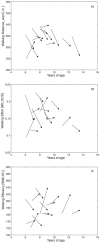Age-related longitudinal changes in metabolic energy expenditure during walking in boys with Duchenne muscular dystrophy
- PMID: 25506914
- PMCID: PMC4266650
- DOI: 10.1371/journal.pone.0115200
Age-related longitudinal changes in metabolic energy expenditure during walking in boys with Duchenne muscular dystrophy
Abstract
Objective: The aim of this study was to evaluate age-related changes in metabolic walking energy expenditure in ambulant boys affected by Duchenne muscular dystrophy over a follow-up period of 12 months.
Methods: At baseline (T1) and 12 months later (T2), metabolic walking energy expenditure was assessed during a 6-minute walk test at comfortable speed in 14 ambulant boys with Duchenne (age range: 6.0-12.5 years, mean 8.2). Outcome measures derived from the assessment included the 6-minute comfortable walking distance (m) and net-nondimensional energy cost relative to speed-matched control cost (SMC-EC, %). Statistical comparisons were made using a two-way repeated measures ANOVA (factors: time (T1 versus T2) and age (<8 years of age (yoa) versus ≥8 yoa)).
Results: Over the course of the study, a significant decrease of -28m (-8.2%, p = 0.043) was noted in the walked distance at comfortable speed. Besides, SMC-EC increased with 4.4%, although this change was not significant (p = 0.452). Regarding age groups, boys below 8 yoa showed a smaller annual decrease in the walked distance (-15 m) compared to boys above 8 yoa (-37 m). SMC-EC increased with 10% in the older boys, while in the younger boys it decreased (-2.1%). The main effect of age group on walking distance and SMC-EC however was not significant (p>0.158), and also there were no interaction effects (p>0.248).
Conclusions: The results of our small study suggest that the natural course of walking performance in ambulant boys with Duchenne is characterized by a decrease in comfortable walking distance and an increase in walking energy cost. The rate of energy cost seems to increase with age, while walking distance decreases, which is opposite from the trend in typically developing children.
Conflict of interest statement
Figures



References
-
- Mendell JR, Shilling C, Leslie ND, Flanigan KM, al-Dahhak R, et al. (2012) Evidence-based path to newborn screening for Duchenne muscular dystrophy. Ann Neurol 71:304–313. - PubMed
-
- Lapidos KA, Kakkar R, McNally EM (2004) The dystrophin glycoprotein complex: signalling strength and integrity for the sarcolemma. Circ Res 94:1023–1031. - PubMed
-
- Bushby K, Finkel R, Birnkrant D, Case LE, Clemens PR, et al. (2010) Diagnosis and management of Duchenne muscular dystrophy, part 2: implementation of multidisciplinary care. Lancet Neurology 9(2):177–189. - PubMed
-
- McDonald CM, Henricson EK, Han JJ, Abresch RT, Nicorici A, et al. (2010) The 6-minute walk test as a new outcome measure in Duchenne muscular dystrophy. Muscle Nerve 41(4):500–510. - PubMed
-
- Kempen JC, Harlaar J, van der Kooi AJ, de Groot IJ, van den Bergen JC, et al. (2014) Reliability of the walking energy cost test and the six-minute walk test in boys with Duchenne muscular dystrophy. Neuromuscul Disord 24(3):216–221. - PubMed
Publication types
MeSH terms
LinkOut - more resources
Full Text Sources
Other Literature Sources

